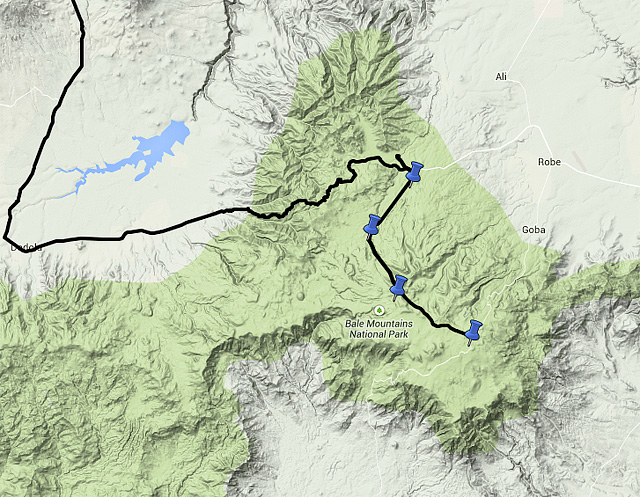field notes
ethiopia, 2014
This was my second and last expedition to Bale Mountains — at least to this part of them. I am planning two expeditions to other parts of Ethiopia; one of them may be the Harenna Forest, but not to the Bale Mountains National Park anymore. The main goal of the past two expeditions — 2012 and 2014 — was photography of the Ethiopian Wolf (Canis simensis). It is an attempt to show this species and its environment in a more artistic way than usual photographs made by zoologists researching the wolf or by tourists. This project isn't finished yet. I am considering an attempt to photograph these animals in other populations although I know that they are much less numerous than in Bale. It is only the chapter “Bale Mountains” in this project that is now closed.
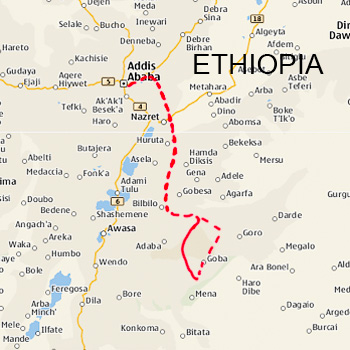
This is the first report that I have almost entirely written during the trip. Most impressions and opinions were written “just in time”. Therefore, this text is real field notes.
To avoid misinterpretations, I as usually begin with a notice that this report is written by a photographer for photographers although anyone else may find it useful or interesting. Some of my opinions and judgements may be not applicable to the situations of other readers. So if you don't agree with something or consider it as not relevant, please bear in mind that you may not be part of the target group.
This report includes only things that were new or different since my previous trip. Almost all that I have written in 2012 remains valid. Therefore, for completeness, please read also the Field Notes from Ethiopia, 2012. I recommend to do it before you continue reading this text.
planning and preparation
I hadn't time to obtain a visa from the embassy before departure and had to make use of the option that citizens of some countries have — to get a visa on arrival. Surprisingly almost all European looking passangers (there were only about a dozen, however) from my plane that arrived from Dubai did the same — made a cue at the visa desk.
Visas issued in the Bole International Airport cost twice as much as those that you get in an Ethiopian embassy in your country — 50 vs. 25 US dollars or 43 vs. 17 euros. Also payment in some other common currencies (British pounds, Swiss francs, etc.) is possible, but not in Ethiopian currency. It is better to have the exact payment amount because they won't have change if it should be coins. Therefore, the real price of my visa was 45€, and I regretted not to have prepared 50$ instead. Airport issued visas have the form of the same sticker that you otherwise receive from an embassy.
Actually, I planned to have travel mates for this trip. I invited up to 3 persons — photographers or just interested in wildlife watching. Three persons had contacted me, but all three changed their plans shortly before the beginning of the trip. Therefore I traveled alone also this time. Now I am glad that had no travel companions because many things were different than I had expected and announced.
It wasn't such a thorough preparation as before my first Ethiopia expedition. I had already two most important contacts in the country — a driver and a guide. I just called them from home and told that I was going to come again.
getting there and around
Previous time I flew from Nuremberg to Addis Ababa via Amsterdam with KLM which is my favourite airlines because they allow 2 pieces of checked luggage up to 20kg each and 12kg of hand luggage on the flights to Africa. Therefore I could tranport around 55kg of photography and outdoor equipment and pay only the price of the ticket for that which was a little more than 500€. This time KLM offers were much more expensive — even from Munich and Frankfurt. The cheapest offers were by Emirates Airlines, and I could get a return ticket via Dubai for 721€. However, it was not from my closest airport — Nüremberg — but from Munich. That means that I had to add 52€ to this amount for train tickets. Overall the trip to Addis Ababa and back to Europe was around 50% more expensive. Maybe it was due to Christmas holidays, and the prices improve in other parts of the year.
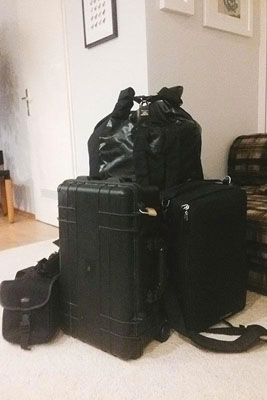
My luggage packed for this trip. (My photo equipment was already inside, so I had to use an iPhone to capture this image.) I had a 140l waterproof sack and a waterproof PELI style case in the checked baggage. The F-Stop gear bag (ICU) with lenses, camera and laptop was my hand baggage. Total weight of all this was over 40kg. (Click on picture to enlarge.)
There are now only expensive yellow taxi cars at the airport. No blue Russian Lada cars anymore. A 20 minutes drive to the RAS hotel costs 600 ETB, i.e. 24€ — same price as in Germany. In 2012 I paid 12US$ and thought that it was much. More than that: The driver will be requesting a “tip” if there was a trafic jam, and you were standing in for 10 minutes or longer. The driver simply dosen't see that taxi is paid per kilometer.
You can still find blue taxi cabs outside the main parking lot.
Public transportation in Ethiopia is cheap but very bad. I used it a couple of times to go from Dinsho to Robe, inside Robe, or to Goba and back to Sanetti Camp. I would't recommend it to anyone. If you are an adventurer with strong trend to masochism, or if you, like me were born and grew up in USSR, you can try it. In Africa people say: “Matatu is never full.” In Ethiopia all public transportation means are never full. A bus will wait till about double as many passengers are in it as there are seats. This may take one or even two hours.
Hitchhiking is possible in Ethiopia, and I did it two times — going from Sanetti Camp to the next towns of Goba and Robe. However, one needs a lot of time and luck to get a lift. An Ethiopian driver normally expects that you pay. European expatriates usually will give you a lift free of charge.
accommodation
As for my previous visit, I didn't book a hotel in advance this time, too. Meanwhile it became possible to book hotels in Addis Ababa online — via such sites as hotels.com or expedia.com but their cheapest offers were single rooms for 50-70US$. Of course, there are plenty of cheaper and quite good hotels in Addis Ababa that cost less. However, they have no online booking. Of course, you can call them from abroad and ask for a room, but normally they do have free rooms. My favourite place to stay is RAS Hotel. It is quite poor, if measured at European standards, and may be rated with not more than 2 stars. But this is Africa, where good hotels are insanely overpriced due to readiness of many Westerners to pay any amounts of money for staying in conditions that fit into their sense of “security” and comfort. This simply drives the prices high but not the quality of living and service. I too would want it to be like in a midrange hotel in a German city, but in Africa it is a norm to demand at least twice as much money for that, and even then the reality is not at German level. Therefore, I don't want to support greediness and am always looking for hotels that cost 30-40US$ per night. One of them is RAS Hotel where I usually stay in Addis Ababa. So was it this time, too. I got a single room (that had a wide double bed, however) for 34US$ per night. The room was good enough for my requirements. The hotel is located not far from the city centre, and is even a place where Nelson Mandela stayed during an African Union conference many decades ago. The hotel staff is extremely nice and fair. RAS is a fairly large hotel but usually has many empty rooms — at least in that part of the building where rooms are offered to foreigners. I observed that not only me but also other foreigners stay there only for a night or two. In the whole hotel there were not more than 4 or 5 foreigners, including me. The hotel has a restaurant in the 2nd floor and a large bar in the ground floor that actually works as a restaurant and appears to be very popular among locals. It is always full in the lunch hours — between 1 and 3 p.m. It is everything else than a gourmet restaurant but the food is eatable and priced reasonably.
However, the quality of food is sometimes difficult to estimate. I drank a juice that was served for breakfast and got very sick a few hours later. First I thought I would vomit the stomach out of my body. Fortunately, the sickness was gone the next day — maybe just thanks to medicine (Imodium) that I took.
two my camps in this expedition
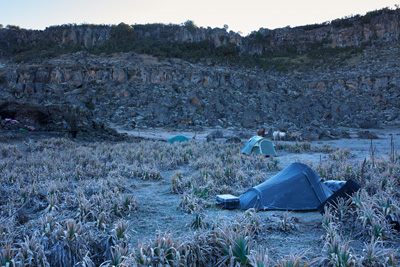
Habera Camp in Web Valley. I was staying there in 2012 too, but this time it was much colder. (Click on picture to enlarge.)
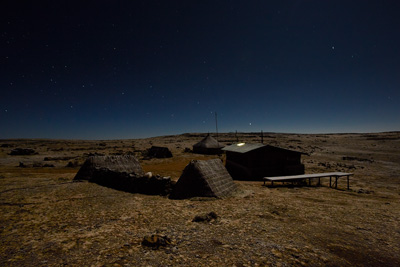
Sanetti Camp was built for Ethiopian Wolf researchers and monitors but other visitors with own tents can stay there too. (Click on picture to enlarge.)
In Dinsho I decided to stay in “Dinsho Lodge” though I didn't like it last time. As I mentioned in my report from the trip in 2012, the lodge was poor but cheap. Now, it didn't get better but got much more expensive. For instance, for a bed in the same dormitory room as before — with 11 beds — that was for 60 ETB (3US$) now 20US$ are demanded. A single room costs now 45 US$. They didn't improve anything since then. Particularly, toilets and bathrooms are as awful as they were two years ago or even got worse. This huge jump of the price can be explained only by changed management. The lodge appears to be managed now not by the park but by a private tourist company. Unfortunately, the huge flow of tourists creates a demand for such accommodation. The lodge has only 6 rooms. In the same evening when I arrived there were at least 11 tourists, and the lodge was full. The next night there were also about as many guests — but all new people. Tourists arrive every evening and leave every morning, and are apparently ready to pay such money because it is anyway the most comfortable accommodation in this place. Of course, very few tourists sleep in tents because very few are going for a serious trekking for many days. I had an impression, that for the majority of people the visit of the Bale Mountains National Park was limited to one night stay on the way to somewhere else. The only reason why I stayed in the lodge was that I was too sick and urgently needed a bed. Otherwise I would have stayed in a tent. By the way, for your own tent to be pitched near the lodge this company charges 10US$, while you can do the same on the official campsite — just 100m uphill — or almost anywhere else in the park for free when you paid a camping fee to the park.
With growing “eco-tourism” things are getting worse in Ethiopia just like everywhere else. I have been told that a British entrepreneur constructed a new lodge on the camping site in the Harenna Forest called “Katcha”. This word means “clearing” and I was camping there during my previous visit. This lodge is priced starting from 150US$ (“low season” price) per night although there is quite little to see near it. In reality, watching Mantled Colobuses from a very large distance is all what can be guaranteed for “normal” tourists. Other forest wildlife is crepuscular and finding it requires much effort, skills and time. Of course, the lodge would mainly serve bird watchers. Many of them are strange people who want a comfortable accommodation, but would like to watch the rarest birds for a couple of seconds. Why not to stay in a tent in the place where those birds live?
Obviously, during the rest of the trip I slept in a tent. I brought a very small tent that was intended for backpackers because I need to save every gramme of luggage weight. It proved to be too small for my body size and, of course, for equipment. Finally, the guide who was only about 1.5m tall offered me his larger tent when we arrived at the second campsite and took mine. In reality he didn't use it because he preferred to sleep in a cave or a hut that was at every place where we overnighted.
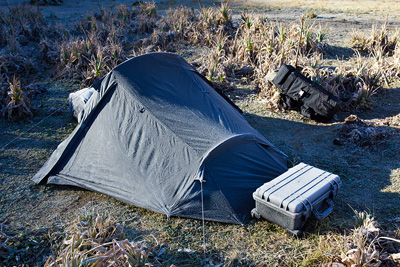
Tents like this are very lightweight but living in it for weeks is a real pain. They are not only too small for an adult European man, offer no space for equipment, but also are not suitable for cold climate like in Bale Mountains. (Click on picture to enlarge.)
I don't recommend “ultra light” trekking tents (see picture on the left) for use in an expedition like this. The tent should be so large that there would be enough place for all your equipment inside because outside it is very dusty. Second, the tent should be so high that you can sit in it. Otherwise any normal activity that you do inside the tent such as changing cloths would be a real pain.
The nights in Bale Mountains were even colder this time than during my previous visit. The temperature was everywhere below zero — sometimes 10 or more degrees. I underestimated this and brought a too thin sleeping bag. Fortunately, I could buy in the town Robe that was the next to Dinsho a large blanket for equivalent of about 17€. This blanket saved the expedition or maybe even my life.
Everybody going in the same season to Bale Mountains is advised to bring a warm sleeping bag — with comfort temperature up to -10°C — and enough warm cloths, including warming lingerie for sleeping and activities after sunset, such as night photography, or early in the morning. Also a good sleeping mat is very important — one that is at least 3cm thick.
the route
I didn't plan the complete route before the expedition. I only knew that would need one whole day in Addis Ababa — to meet the driver and to exchange the money. I also was planning to spend 3 days in Dinsho — to photograph wildlife and to make all arrangements for the rest of the trip that was supposed to be like in 2012 — hiking, and the luggage transported by horses.
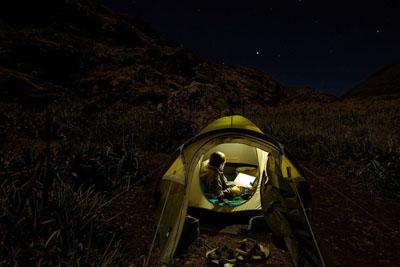
I had a chance to celebrate the New Year 2015 in the coldest place of Africa — the Sanetti Plateau. Even more than that — I was staying in the night of January 1st, 2015 at almost 4000m above sea level, in the coldest part of it. Certainly, this was the most unusual New Year night in my life so far. (Click on picture to enlarge.)
The guide had to suggest me the route through Bale Mountains according to his information about wolf packs. After the guide told me his new prices, financial considerations played also an important part in the dicision about the route.
Finally, we agreed with the guide that we start in Kotera Plain and spend there 3 nights in a camp at Finch 'Abera waterfall (Habera Campsite) in Web Valley. After that we walked to Sanetti Plateau with a stop en route for one night at Wasama mountain. On Sanetti Plateau we sent the horses, horse assistants and the cook back to Dinsho and spent the rest of the time in a camp near the road so that the driver came and picked us up at the end of the expedition, i.e. a return to Dinsho wasn't planned.
Both, on Kotera Plain and on Sanetti Plateau, there were wolf packs with pups, and a lot of other wildlife. Since I am always trying to avoid frequent changing of places, only one day of stay on the way was fine for me. Of course, all together 3 days were lost because of transit from Web Valley to Sanetti Plateau. Previous time there were more “lost days“.
The stay en route was on December 31. It was a good timing. Hence, the first part of the expedition was in 2014, the second — in 2015. It was the most unusual New Year night in my life so far.
logistics
It was similar to described in my report about the trip 2012, with one big difference: I didn't go to the park office at all. On the day of arrival I was sick and only greeted them from the car. The next day was Friday, and the guide told me that the office was closed. He took the money and sad that he will do all formalities with the park himself.
organisation
Maybe I made a mistake letting my guide with whom I had an arrangement previous time orgainise everything. As a consequence, everything was for me much more expensive. First I called him about three months in advance and told that I was going to come at the end of December. He told me that everything would be prepared. The next morning after my arrival in Dinsho we met and he surprised me with ”new prices”. To my protest he replied that the prices in Ethiopia generally had grown. That was a lie. Then he told me that there was an inflation of their currency. It was complete nonsense because his prices had increased many times also in euro equivalent. The difference in the exchange rate of Birr to Euro only about 2 ETB — in 2012 1€ was around 21-22 ETB while this time the official exchange rate was 24.30ETB to 1€. Of course, he told me the real reason: "You are a photographer, this is not much money to pay for a photographer... Others request more..." This made me particularly angry because I consider photographers as travellers with the least money after they have purchased all the equipment needed and paid the airlines for excess baggage. I don't know who among the photographers has been doing such bad service to others — throwing in Ethiopia with money — but apparently there was someone, and he remained in memory of people in this country for long.
At the end of my quite emotional negotiation I managed to cut the price to almost a half. Finally, we reached an agreement. After I had more time for thinking, the next day, I already regretted that I didn't just go and look for other people instead hiring him but it was too late. I had already paid him.
In the Web Valley — the closest place to park headquarters with Ethiopian Wolf packs — he told me some more details. Photo tourists started coming by cars to this place to photograph the wolves at a den in breeding season. I didn't understand who exactly organises such drives — either the park office or the wolf conservation programme office. According to my guide, for one such drive tourists pay 1,000US$. The car goes the directly in front of the den, the tourists photograph through the windows like on a safari in Tansania. After that they return to Dinsho. The guide told that there are also other, more extended offers to very high prices, including staying in the researchers camp for several days. Certainly, such offers are not an option for a nature photographer unless his expenses are covered by a magazine or an agency. There is also the second reason why I think that no photographer would do it: The distance from the road to the den is usually about 100m — too far for photography.
The guide told all this in support of his claims that his service and conditions are very attractive. I don't know how much of that was true and whether I understood him correctly, but I am inclined to believe much of this story. Anyway, at least the TV companies who are frequent customers and also donors of the Bale Mountains NP raised the expectations of the people working in or at the park. A photographer like me has in such circumstances usually a hard task to explain that he has nothing to do with show business.
To reduce the expenses for me, we agreed that the cook and the horse assistants will work only 7 days. The rest of time only we two will spend in Sanetti Campsite and tell my driver to pick us up from there instead from Dinsho as it was initially planned.
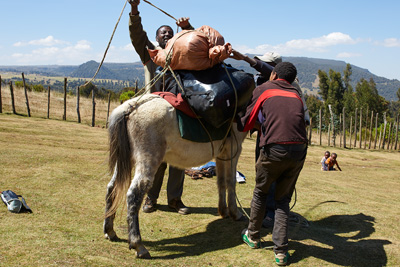
Soft-shell bags like my black Ortlieb sack shown on this picture are better suitable for transporting on a horse because they can be bent. However, it is importent that the content of the bag at at least one side is soft. You should not forget this when packing. (Click on picture to enlarge.)
This time I needed only 3 horses because the duration of trekking in Bale Mountains was shorter and because I had only two pieces of luggage with combined weight of around 40kg, and not over 55kg in 3 pieces as last time. Therefore only two horse assistants were necessary.
The horse assistants were the same men who worked for me in 2012. The cook was a new person — a nice young man. He really was able to cook unlike the girl who was in charge of cooking during the trekking in 2012, but in reality could only boil rice or noodles.
food and water
Food during trekking in Bale Mountains became also more expensive for me this time. For the same food (rice, noodles, onions) they requested almost 3 times the price of 2012. I paid 5000 ETB (about 210€) and added the fish preserves for 500 ETB (about 20€) that I had purchased in the capital. I had a strong suspicion that either the guide or the cook cheated me. Anyway, the prices in the supermarkets in Addis Ababa didn't look very different than during my first visit 2 years ago. Five days before the end of the expedition the guide told me that food supplies that were bought for 230€ ran out. This means that 230€ were not enough for providing 3-4 persons mainly with rice and pasta for just 2 weeks. I don't believe this! The guide also knew that I don't. Therefore he didn't request more money for purchasing more rice and pasta.
However, I must admit that the food in the field was much better this time than in 2012. The cook was doing his job very well. Of course, dishes that he was preparing mostly were creations from rice and noodles, but he served with them even a salad with avocado. For dinner he cooked absolutely fantastic soups. This continued only 5 days. After that the cook went back to Dinsho and I stayed with the guide in Sanetti Camp for almost 8 days. The guide arranged with the guard of the camp that he will cook for us till our departure for 1000 ETB.
This time I hadn't brought a water filter due to limited weight of my baggage. In Addis Ababa and on the way to Dinsho I bought a couple of 2l bottles of water for 13-15 ETB each. I drank some of this water on the days in Addis Ababa and Dinsho. The rest I put in hydration bladder and took with me to Bale Mountains.
At both places of my stay — Habera Campsite and Sanetti Campsite — there were sources of good clean water. No filtering or chemical treatment were necessary.
electric power
Nope. There is no electricity in Bale Mountains — read my report from 2012. Even in Dinsho Lodge none of power sockets worked.
I was using the solar charging kit Sunload that I praised in the report 2012 again for powering and charging my notebook, head lamp and mobile phones. I didn't charge any batteries for the camera because I brought 8 pre-charged spare batteries, i.e. including the battery already installed in the camera I had 9 batteries. This was more than enough for 2 weeks in the field: 3 batteries remained unused.
communication
Nothing has changed in terms of availability of communication means since 2012 in the places on my route, but for me this time it was very different. My Thuraya XT satellite phone without any obvious reason got broken when it was just stored in a box at home for several months and I wasn't using it. It refused to switch on, nor the battery was charging. My first thought was, of course, that the battery got completely drained and thus damaged. This is unlikely with modern batteries and such expensive devices but who knows... I contacted Thuraya via service e-mail describing what happened. They replied too that it may be a battery and advised me to address their service partner in Germany. However, this advice was useless because I discovered that the telephone is not functioning on Friday, and my departure to Ethiopia was on Monday. So the only way for me to get the telephone working was to get a replacement battery. Since satellite phones are rarely purchased, spare parts and accessories in Germany are available only from two or three companies who have no shops and distribute everything via Internet. One of these companies is in Munich, and my departure airport was also there. My flight was in the evening. Therefore, I called the company in the morning and told that they are my only hope. The owner of the company was so kind to allow me to come and to pick up the battery. I did it. After I installed the battery into the telephone, it still didn't work. This is why I had to use the cellular network in Ethiopia during this trip.
The biggest problem with it is that the coverage is extremely poor in Bale Mountains. On my route there were only two spots where my mobile phone with an Ethiopian SIM card could find the network “Eth Tel”. One was near my camp at Finch 'Abera waterfall. It was just a hill like others. The guide showed me the place, otherwise I never had suspected that there was a reception. It was an area of about 10x10m where I needed to walk around to find a spot with a signal strong enough for sending and receiving a text message or even for calling. I could even call abroad from there. Here are the coordinates of this place: N7 00.979 E39 43.456.
The second place was about 7km from Sanetti Campsite: N6 53.308 E39 48.001. A good reception was easier to achieve there.
Text messages sent to foreign networks arrive with long delay — sometimes two days later. This means that if you have sent a message to someone at home, don't expect a soon reply.
Getting an Ethiopian SIM card for a foreigner was not so straight forward as in other countries. Anyway my driver told me that mobile phone numbers have to be acquired in some kind of bureaucratic procedure. To make things simple he just gave me a SIM card of his brother who wasn't using it at that moment.
Scratch cards, or to say better — stripes, are available in any shop. They were for 100, 50 and less units, and priced accordingly — 100, 50, etc. birr. An SMS abroad costs quite much. I don't know the exact price but had an impression that almost 10 ETB. As it was to expect, calls abroad were expensive. I minute of calling of a German telephone number was around 30 ETB. However, all this was much cheaper than using a German mobile phone in Ethiopia via roaming.
bottom line
costs and expenses
Hurry to come to Ethiopia before it is even more overpopulated and overcrowded with tourists! Mass tourism spoils not only remaining very few nature sites but also removes the charm of this country — not to mention that travelling becomes more expensive.
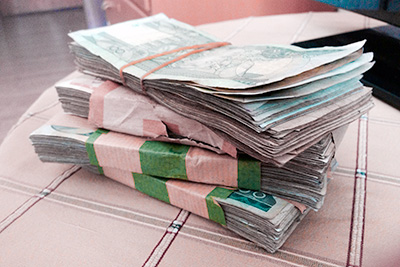
30 000 birr that I changed on black market upon arrival. Even after that I needed to go to a bank in Robe a couple of times. (Click on picture to enlarge.)
While in 2012 for a 23 days expedition I paid (including flight) about 2500€, this time that were almost 3000€ for 19 days. In 2012 from 23 days 19 were in the field; in 2014 that were only 15 from 19 days.
As I already mentioned, the flight was much more expensive than previously.
The price for the car remained the same — around 100$ per day. Normally, drivers in Addis Ababa request 120$ per day. Negotiate!
Car fuel was a bit cheaper due to international price drop for oil. Fuel consumption is somewhat higher at high altitudes. My driver told me that his Toyota Landcruiser needs 1 litre per 7 kilometers, i.e. about 14l per 100km.
The park fees remained the same, but other my expenses in Bale Mountains increased dramatically. I needed 3 horses and 2 horse men. The horse men requested 250 ETB per day, i.e. plus 66%. For the horses I had to pay 200 ETB each, i.e. 600 ETB per day for 3 horses, i.e. increase by 100%. The highest increase in price was for the cook and the guide. The guide requested first 1000 ETB per day explaining this by specifics of work with a photographer. I negotiated this price down to 500 ETB per day. It was, of course, still a lot compared to 170 ETB per day in 2012, but such salary appeared to me reasonable because indeed the work of the guide may be harder with a photographer than with tourists although he usually has much free time during the day. Another question is whether he did work more. No, the same man who did excellent job for 170 birr per day now was lazy. The first three days he went with me only once a day — in the morning. In the rest of time in this expedition I was always alone, and the guide stayed in the camp. I don't know how the official prices currently are. If 170 ETB is still valid for general guidance then 250-300 ETB should be appropriate as a salary for particularly helpful guide.
Of course, guides and other workers also expect that you tip them. I wasn't in a mood to do it after I had paid so much as a salary but had to because the tent that I brought from home was planned as a tip for the guide. I couldn't and didn't want to carry it back home in my luggage. He got this tent and also the blanket that I had purchased in Robe.
It appeared to me that the whole country was rushing for money — starting with doubled visa fee and ending with insane money for food supplies.
peculiarities
The most peculiar thing that I encountered during this trip was the question that my guide once asked me: “If you have no children, why don't you give money for raising a child in Africa?” First I was shocked by this idea but then did my best to explain him using simple words (because his English was not very good) that the main reason why so many people in Europe have only one child is that they cannot afford more, and childless people cannot afford any children.
This was not the first time that I encountered this mentality in Africa. Many view us, Europeans, barely as donors of everything. An hour before the same person was telling me that he had heard on TV that “Germans want a country only for Germans” and asking if it is true. I told him that it is nonsense, that migrants aren't discriminated in Germany and that those who are ready to integrate into German society are welcome. (Probably he had heard a news report about PEGIDA demonstrations and misunderstood it thinking that it is a general trend.) I explained him that some critical opinions in Europe about migrants are currently caused by cases of islamic fundamentalism and by the never ending flow of north African migrants to southern Europe and from there to other countries. Of course, he heard about that and he also knew the reasons of poverty in Africa — and that rapid population growth is among them. When I reminded him about that he told me that he is aware that the population of Ethiopia alone grew in less than 30 years from 90 to 120 millions. Nevertheless, a little later he got that silly idea about me sponsoring an African child. Of course, he may have heard that some people in the West do such things. I told him, too, that there are such people, but they are rich and have everything — also own children. I didn't tell him what I really think — that such people are doing evil because they are just enjoying own wealth through contributing to African poverty.
The use of water by local people is also one of things that are to be mentioned among peculiarities that I noticed during this trip. In Oromia (I don't know about the rest of Ethiopia) the idea that water bodies (rivers, lakes, streams) are source of drinking water and should be protected is absent. Local population prefers to use rivers and streams for toilet. It looks like my guide didn't even think to make his big business on land. He always needed a stream for it. After that he washed his bottom in the same water. That a few hundred meters further people may be using this water for cooking or washing didn't bother him at all. Also he had no problem with the possibility that feces of someone who did the same in that stream at its higher current. If thought further, since the rivers from this part of the country are the main water source of Somalia, what they get are fluid feces from Ethiopia considering the number of people living there along the rivers.
Another strange thing that I noticed was that celebrating the New Year apparently isn't that popular in Ethiopia as we may think when we are in Europe. On one hand, I was seeing plastic New Year trees (= Christmas trees) offered in shops and public places in Addis Ababa were decorated with Santa Clauses and other seasonal attributes. On the other, nobody from my staff in Bale Mountains was even thinking that it was New Year when we arrived in our first camp on Sanetti Plateau. That they are muslims and don't celebrate New Year isn't an explanation because one of them (the cook) was christian. When I reminded them that it was New Years night they showed absolutely no enthusiasm. After dinner, when I was going to my tent, I wished them a happy New Year. Only the guide replied.
When I arrived in Bale Mountains National Park in Dinsho there were many people celebrating something. The guide told me that the “President of Oromia” had just left. The regional politician had a meeting with the electorate in the Dinsho Lodge. After that there was a dinner. Therefore I had to wait a little till they finished. After everybody was gone, I entered the hall of the lodge and my foot slipped on something. When I looked down I saw that the whole floor is covered by bones (goat or lamb ribs) and soft-dring bottle caps. It appeared that elders and other distinguished representatives of the local community in process of dining were just throwing bones and bottle caps on the floor. I also noticed in different situations that people in Oromia were not picking litter that they occasionally had dropped even if the floor in the room was otherwise clean.
safety, security, staying healthy
There were no new issues concerning personal security. I still believe that Ethiopia in general is a pretty safe country. The farther you are from cities and towns the safer you are.
In the RAS Hotel I did the same safety precautions that I described in 2012 — locking all my bagage and tying it with a metal cord together. However, I didn't use that PackSafe mesh this time. In the field I was leaving my many thousands euros worth equipment simply in the tent because there were no other people around than those whom I had hired to work for me.
I had drawn conclusions from the sunburns that I got during the previous trip. I was using a Sun Shield creme with factor 50 on my face, and it absolutely remained normal like at home. Because I washed the hands several times during the day I couldn't use the same protective creme. In the sun I was wearing simple fabric hand shoes. They were protecting my hands not only from the sun but also from dust and injuries through thorns and sharp stones.
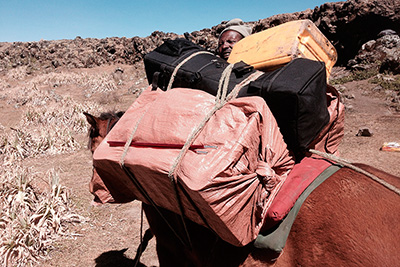
Here is how my 12K€ worth lens (in a black LensCoat bag) was traveling on a horse. smile emoticon Good that Canon super teles are so sturdy! (Click on picture to enlarge.)
Even more than in 2012 the environment in Bale Mountains was harsh. In December and January it is much colder than in late Februar and early March — the time of my previous visit. This was difficult not only for me but also for any kind of equipment I had. For example, the ballhead of my tripod didn't work properly early in the morning because the ball wasn't rolling well at frost temperatures. Also there were issues with the Sunload solar charger causes by frost: For it to work, I had to put it in my sleeping bag.
However, all lenses and the camera were working fine even in very low temperatures. The biggest surprise was my Macbook Air: In Ethiopia it worked fine at altitudes of more than 4000 m above sea level although in Central Asia it couldn't be used already at 3500 m because of overheating (see my article “Some Thoughts About Image Storage in the Field”). Probably it was due to much colder air in Bale Mountains: The computer just didn't need cooling when the environment temperature was only a couple of degrees above zero.
In Web Valley and Kotera Plain, i.e. during the first week of the trip, it was less dusty than in February 2012. However, much dust was elsewhere in Bale Mountains, and it was very annoying because the equipment and everything else was permanently dirty.
photographic experience
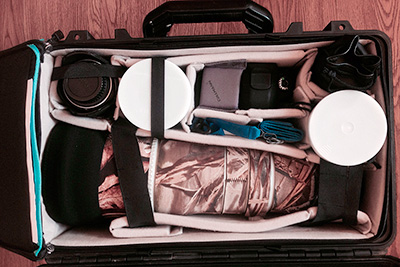
Because of the need to reduce the weight of the luggage I took only 5 lenses — 15mm, 18mm, 30mm, 85mm, 600mm — and only 1 camera body. All this could nicely fit into hand luggage. The case was compact but very heavy. (Click on picture to enlarge.)
My telephoto lens had this time double as long focal length as the one that I was using in 2012. Therefore, photographing wildlife was much more pleasure because it was easier and the results were better. This is the main difference from the previous expedition. Other things that I wrote in my report 2012 are still valid.
In this period of the year the “golden hours” were from 6.00 to 7.30 in the morning and from 5.00 to 6.00 in the evening.
wildlife photography
This time I had a definite main subject — the Ethiopian Wolf. However, I captured this time more images of wildlife than 2012 due to better equipment. I didn't take a macro lens to this expedition because I knew that there won't be such subjects in this season and the places I was going to visit.
Invertebrates, etc:
You can find some butterflies, dragonflies, spiders and other invertebrates in Dinsho area. However, none was really attracting my attention. Unless photography of insects and spiders is your passion and you photograph just them all, there is no sense to bring equipment for macro photography if you come to this place during dry season. High in Bale Mountains I saw no ground dwelling arthropods, but flying insects were there. Unless for entomologists I haven't seen any spectacular insects.
Reptiles and amphibians were also absent in the areas I have visited.
Birds:
As I am usually meaning, for best results you should focus on one or few subjects. This time I had the equipment that was best suitable for bird photography, too. However, I photographed birds only occasionally because I had no time to concentrate my attention on them. The problem was that birds have to be photographed early in the morning and late in the afternoon. This was the time when I was occupied with the wolves.
Birds were present everywhere. In Dinsho area many forest birds live which are difficult or impossible to photograph because most of them stay high in canopy. Fortunately, some species can be found in shrubs. That makes our work easier.
I am a big fan of tripod but am very sceptical about its real-life usefulness in bird photography. You have to walk all the time and to search for the birds. Most birds are very agile and don't stay even for a couple of seconds without movement. They show up in open places where you can shoot them with your camera only for a few seconds. Honestly, I can't imagine how a tripod can be used in such circumstances and with such subjects. Although I have a tripod with me, I usually end up with holding the camera with hands even when I am using a 600mm or longer lens. Often I prefer a monopod to tripod.
In Bale Mountains there are wide open spaces and gorges where you see raptors and many other species of birds. Even in this dry season streams and ponds remained that were attracting even some shore birds. All of bird species in Bale Mountains are quite shy, and much time and patience are necessary, not to mention a very long focal length. In this expedition I had patience and enough focal length but almost never time. The good light for photography is vanishing very quickly in the morning. Already at 8 a.m. it is very harsh. Therefore effectively the time for bird photography in the mountains is from 6 a.m. to 9 a.m. and in the afternoon — from 5 p.m. to 7 p.m. Since rocks are casting deep shadows when the sun is low, places with good lighting for photography are additionally difficult to find.
Mammals:
The main focus of this expedition was on the Ethiopian Wolf, but, of course, I photographed all mammals I came across. First of all I photographed ungulates who live near the BMNP office in Dinsho. Nothing changed since my last visit except a group of warthogs that visited every morning at 8 a.m. the Dinsho Lodge to search for eatable rubbish.
The most impressive excursion was to Gaysay grassland near Dinsho because I could not only could photograph many ungulates in more wild environment than at park office, but first of all because I finally got some nice shots of a Serval. That plain is a place with the best chance to spot this cat, and I was lucky. I didn't take a tripod with me but only a monopod that also worked well. However, I would recommend to go to Gaysay grassland with a tripod because there are best opportunities to use it.
Another good place for photographing mammals was Web Valley although I was entirely occupied with wolves and had no time for other subjects. In Web Valley you find Ethiopian Wolves (Canis simensis), Mountain Nyalas (Tragelaphus buxtoni), Rock Hyraxes (Procavia capensis), Olive Baboons (Papio anubis), Common Warthogs (Phacochoerus africanus), Ethiopian Highlad Hare (Lepus starcki), many rodents including Big-Headed Mole Rat (Tachyoryctes macrocephalus).
A less good place is Sanetti Plateau where the Ethiopian Wolf is largest animal. Except this species Ethiopian Highland Hares, Rock Hyraxes and rodents live there.
Only for Mountain Nyalas in Dinsho 300-400mm focal distance should be enough. With my 600mm lens I often hat to run back because the nyala was too large and too close. For the rest of mammals, like for birds, 800mm is optimal, i.e. I often had to use the 600mm lens with a 1.4x teleconverter.
ethiopian wolf
This expedition was during breeding season. Actually it was already the period when in some places pups are about 1 month old. They were already leaving the den to sleep together with the rest of the pack outside. During the day they were hiding in the den and waiting for feeding.
In other places pups were only a few weeks old. They were small and not good at running. Such pups were always staying in the den or near it when the parents or pack members were there too.
The best opportunity for photography is when you find the den. All guides in Bale Mountains know the areas of wolf packs because they show wolves to tourists. Dens aren't supposed to be visited by tourists although many photos of pups in the Internet may be suggesting the opposite. Since the wolves do not re-use the den, guides normally don't know their location, and it is good so. Otherwise they would bring every tourist to the den.
However, a good guide would find the den if he knows the place in general well. So was my guide: He found the sleeping place of the wolfs and the den in Kotera Plain in the first morning of our stay there. In Sanetti Plateau he wasn't so confident anymore because the area is much bigger and he didn't know the boundaries of the packs. However, I found a den with pups also there.
The Ethiopian Wolves are very shy and nervous. If they are with the pups, they are bound to one place where they sleep and return many times a day. It is possible to hide nearby, thus reducing the distance to as little as 50m. You have to be very careful. If the wolves would notice the photographer, pups would run into the den, and the adults run away. It is particularly difficult because the mother is almost always there.
However, there may be strong ethical considerations against visiting the den because any activities of humans near the den disturb the wolves. Therefore researchers keep the locations of dens secret. If disturbed too much, the wolves may move the pups to a different place. This is a very stressful and risky process.
I was surprised to see how many tourists come to Bale Mountains in this season because they hope to see wolves with pups. One reason is probably wrong advertising by Ethiopian tour companies and guides. Another reason are numerous photographs of cute pups found all over the Internet. I was witness when an American tourist with a shining white Canon 400mm f/5.6 lens was offering money to my guide if he shows him pups. The guide answered that he doesn't know that place, and it was true.
Hopefully, some of people who go to Bale Mountains for a couple of days or even hours and expect to see or even photograph pups would come across this report and read it. Watching the wolves in Bale Mountains is not a safari like in Serengeti, it is much much more complicated and requires much more efforts and time. Therefore if it is for you only a tourism, it is better to forget this idea.
All that I have written about photographing the wolves in my report from the trip 2012 applies also for this season. I was thinking that it is easier to approach them during the breading season. This is only partially true. Due to existence of the den with pups it is easier to find the entire pack. Also it is guaranteed that the wolves always return to the same place. So it is easier to locate them there. However, they remain also in the breeding season shy and therefore are a difficult photography subject.
Most images of wolves I made this time with use of a support. In Web Valley I was using a monopod, but on Sanetti Plateau — mostly a tripod.
Don't believe if someone like my guide will be telling you that wolves when they have pups in a den become less shy and allow closer approaching. The advantage of the breeding season is only that the movements of the wolves become more predictable — they return to the place with the den. However, even then the problem of too large distance for photography them remains. When the wolves get scared, the pups immediately hide in the den, and the adults run away — just like in any other season. At a den you won't approach them closer than 50m anyway. If you are lucky, there may be large stones closer than this, and you can hide behind them, but the wolves will sniff you and raise the alarm.
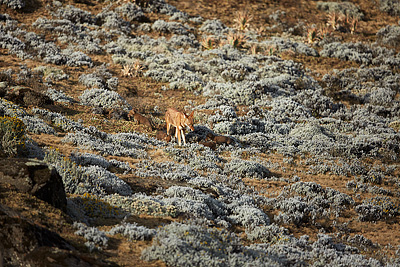
This is an image I got with a 600mm lens at a distance of about 70-80m. There was no chance to approach the animals any closer because there was no place to hide. As you see, such an image isn't useable. (Click on picture to enlarge.)
For good results a focal length of 800mm and more is a must. I had a 600mm lens that works very well with teleconverters, and when I was photographing the wolves I rarely used this lens without. Of course, you can use a 400mm lens but should be prepared to crop the image a lot in postprocessing. Since I always plan to print my images on large formats, cropping isn't an option for me. I got almost all useable images of the wolves I got with 840mm and 1200mm focal length.
The Ethiopian Wolves are very strange creatures. Typically they become hysterical as soon as they notice a human several hundreds of meters away. For me it is a mystery why. There are so many humans in the area where the wolves leave that I would have expected them to adopt and to ignore the humans. However, they may suddenly allow a very close distance. This was a surprise for me during this trip. Once after sunset I got out of my tent and saw a wolf standing in front of me in not more than 10m. It looked at me for some time and went away. It was completely silent, i.e. apparently not scared.
A few words must be said about formalities. My guide was very nervous every time when we were searching for the wolves because he was afraid to get in trouble with park authorities. I couldn't understand this because I had informed people in the park office that I am interested in Ethiopian Wolves and had come to photograph them. On the website of the park you won't find any special rules concerning the wolves. They are the main attraction of the Bale Mountains National Park, so obviously there are photographers like me who come to photograph them. Unless you are doing it for commercial purposes, it is licence free. If you are working on assignment you have to pay a fee to the Ethiopian state. This rule applies for anything in this country that you film or photograph for commercial use. My activities have nothing to do with this because I am acting only as an artist without any concrete plans or chances to earn money with my work. Formally, I am a tourist with strong interest in wildlife like, for instance, birdwatchers. I am not sure whether it was the guide who wasn't understanding the difference, or he just was afraid that someone would confuse me with a commercial photographer or videographer who didn't pay the licence fee.
landscapes
It was again a dry season — enough said. Again I was missing cloudy sky, green vegetation and flowers. Everything I wrote in the report 2012 applies this time too.
The route of this expedition was shorter than in 2012. Therefore, I have not so many new recommendations of locations for landscape photography:
- Web River canyon: Actually it isn't a river yet but a stream that you can easily cross by jumping from one stone onto another. During my previous visit there I concentrated my attention too much on the Finch 'Abera waterfall, and didn't notice the rest of the river banks. They are beautiful and mystically looking. From the campsite go towards the waterfall and turn left into a narrow canyon.
- Sanetti Plateau: It is a harsh but beautiful environment — unique to Africa, and Sanetti Plateau is the largest remaining area of it. Near the Sanetti Campsite where I was staying there are many small lakes and some beautiful views with Giant Lobelias. Overall it is a not the best place for landscape photography because it doesn't have enough variety of views. It is a hilly plaine with rocks and stones; now and then single or groups of lobelias occur.
For landscape photography I had this time lenses with narrower view angle — 30mm and 85mm — in addition to 18mm. In mountain landscape images I prefer a not so wide angle. My 24mm lens that I was using in 2012 I left at home.
final remarks
Overall I achieved what I wanted with this trip. I got many good images of Ethiopian Wolves, also with pups in different ages. This was my main goal. Maybe none of the photographs will be award winning, but most of them are good enough for publications and exhibitions.
There were some problems during this expedition that I in detail reported above. It became more expensive than I expected but is still within the budget limits that I had set for such trips. However, at the end I was grateful to the guide because my work in this expedition weren't as successful as it was without his help. I met other guides and found them maybe more serious and organised but I am afraid that they wouldn't be able to do for me things that my guide did in this expedition and that helped me a lot.
Here are the most important recommendations after this trip:
- Go on such a trip alone. Initially, I wished to have travel mates, but at the end of the expedition I realised that I was lucky to be alone because otherwise I hadn't achieved anything. It is simply impossible to photograph the Ethiopian Wolves being in a group of people.
- Reserve at least 50% more money than you estimate the trip will cost.
- Estimate how much food you and people working for you would need for the whole trip and purchase as much as possible in Addis Ababa. Of course, very much depends from the cook. However, all cooks in this country make dishes mainly from rice and pasta. Therefore, it is possible to roughly estimate the amount of these ingredients along with potatoes, onions, fish preserves, marmalade and similar. The cook should then determine what is missing and tell you.
- Do not seriously count on opportunities to photograph the Ethiopian Wolves at a den. It is a very complicated issue! To do this you will need either a help by the guys from the EWCP (Ethiopian Wolf Conservation Programme) or the EWCA (Ethiopian Wildlife Conservation Authority), or good tracking skills and plenty of time.
